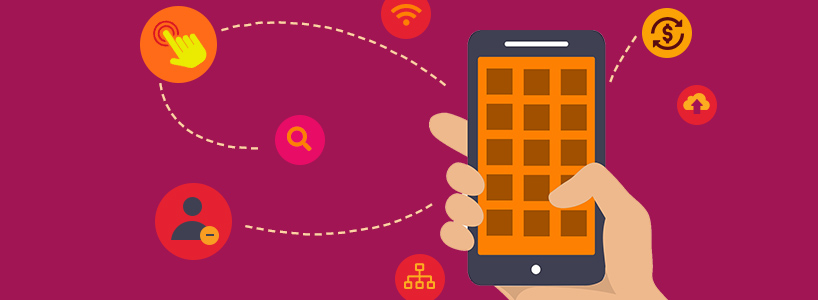Research published by Forrester last summer shows that smartphone users spend 85 percent of their screen time using mobile apps, not accessing mobile websites. Smartphone users then spend 84 percent of in-app time using their five favorite mobile apps.
Although these favorites vary between users, top choices include social media, messaging and search apps. A major shopping app like Amazon's gets about 3 percent of a user's time.
So where does that leave your mobile app project? Let's face it: you've got some serious competition. That's why according to TechCrunch, Forrester recommends designing your apps for loyal customers, not for marketing.
Focusing on loyal customers instead of beating the bushes for new customers can deliver big ROI on your mobile app dollar.
- Return customers visit twice as often, spend 30 to 40 percent more and purchase more high-margin items than new customers. (Source: Mobile Business Insights)
- It costs six to seven times more to acquire a new customer than to retain one you already have. (Source: Intuit)
- You have a 60 to 70-percent chance of selling to a new customer, but just a 5 go 20-percent chance of selling to a new one. (Source: Intuit)
When you build your mobile apps, build them for the customers you already have. These components can make your mobile app irresistible to your best customers.
Your Loyalty Card on Steroids
Whatever type of loyalty program you use points-based, flat discount, intermittent rewards, etc. your app should make it easy for customers to ditch their plastic loyalty cards. A barcode or QR code that cashiers can easily scan, or a simple code for online purchases, means no more carrying around a wallet full of plastic.
Additionally, your rewards program should be transparent on your mobile app, making it easy for customers to track accumulated rewards, spending and redemptions. Adding gamification elements, such as badges for hitting spending or savings milestones, can keep mobile app users coming back.
Location-Based Marketing and Push Notifications
By integrating your mobile app with GPS, you can deliver deals that will encourage customers to visit more often. Emerging tools like Apple's iBeacon technology can push personalized deals to customer smartphones when they go near certain displays or favorite shopping categories within your store.
You can also utilize push notifications to win back customers who haven't spent money with you in a while. If loyalty point accumulation slows, or mobile app usage ceases, a push notification sweetened with a discount can get customers back on track. Just make sure you're offering deals exclusive to mobile customers deals they can't get through other channels if you want them to continue using your app.
Mobile Wallet
- Half of all in-store Starbucks transactions, according to Bloomberg, may soon be processed through the coffee chain's mobile app. Customers can upload gift cards to the Starbucks mobile app and refill them anytime, either in store or by linking their credit cards to the app.
- If you're concerned about keeping smartphone data safe or storing customer credit card information on your own servers, ask your developer about APIs that integrate with native secure payment solutions like Apple Pay or Android Pay. Also, make sure that mobile wallet integrates easily with customer loyalty points and discounts so that customers get every advantage from your loyalty app.
Data for You
- The biggest advantage you get from encouraging loyal customers to use your mobile app aside from revenue, of course is access to a treasure trove of data. Depending on permissions granted by customers, you can track shopping preferences and mobile app usage habits, at the very least, to develop new insights into your best shoppers.
- By integrating mobile app data with your CRM program, you can build a highly targeted profile of each customer that informs marketing strategy across multiple channels. The data you collect can help you develop personalized content for content marketing, personalized email or dynamic website coupons for the things customers actually buy and mobile offers targeted at the times of day customers usually shop.
Continuous Updating and Development
Launching an app is never a one-and-done deal. You need a long-term partnership with your app development team. All the data you collect should inform how you update the features and functions of your app.
The bottom line: when you create your mobile app, build it for the people who will actually download it, configure it and use it. You can't compete with Facebook, WhatsApp or Google for the world's off-hours browsing time. You can make your app a can't-miss destination for your most loyal customers.


7 thoughts on "Build Your Mobile App Around Customer Loyalty Instead of Marketing"
Oracle Fusion HCM Training
14 November, 2024 at 5:37 pm
This is a great read. This post kept me hooked till the very end.
Cancel
Reply
mark
01 November, 2024 at 9:34 pm
I learned something new from this Blog.
Cancel
Reply
Oracle Fusion HCM Training
31 August, 2024 at 12:13 pm
Thanks for the informative article.
Cancel
Reply
Ritu Sharma
25 April, 2017 at 12:35 pm
The blog was absolutely fantastic! Thanks for sharing the blog. Great job, keep it up..
Cancel
Reply
Alexis Gil
29 December, 2016 at 6:38 pm
Thanks for this statistics! This information can help a lot while making a decision. Of course the most important part of the process is to analyze at every stage. As many businesses, as many combinations of different strategies.
Cancel
Reply
Quuick
22 December, 2016 at 6:45 am
Great info. I love all the posts, I really enjoyed, I would like more information about this, because it is very nice., Thanks for sharing...
Cancel
Reply
Ieinfotech
17 December, 2016 at 6:12 am
Thank you, appreciate your sharing.
Cancel
Reply